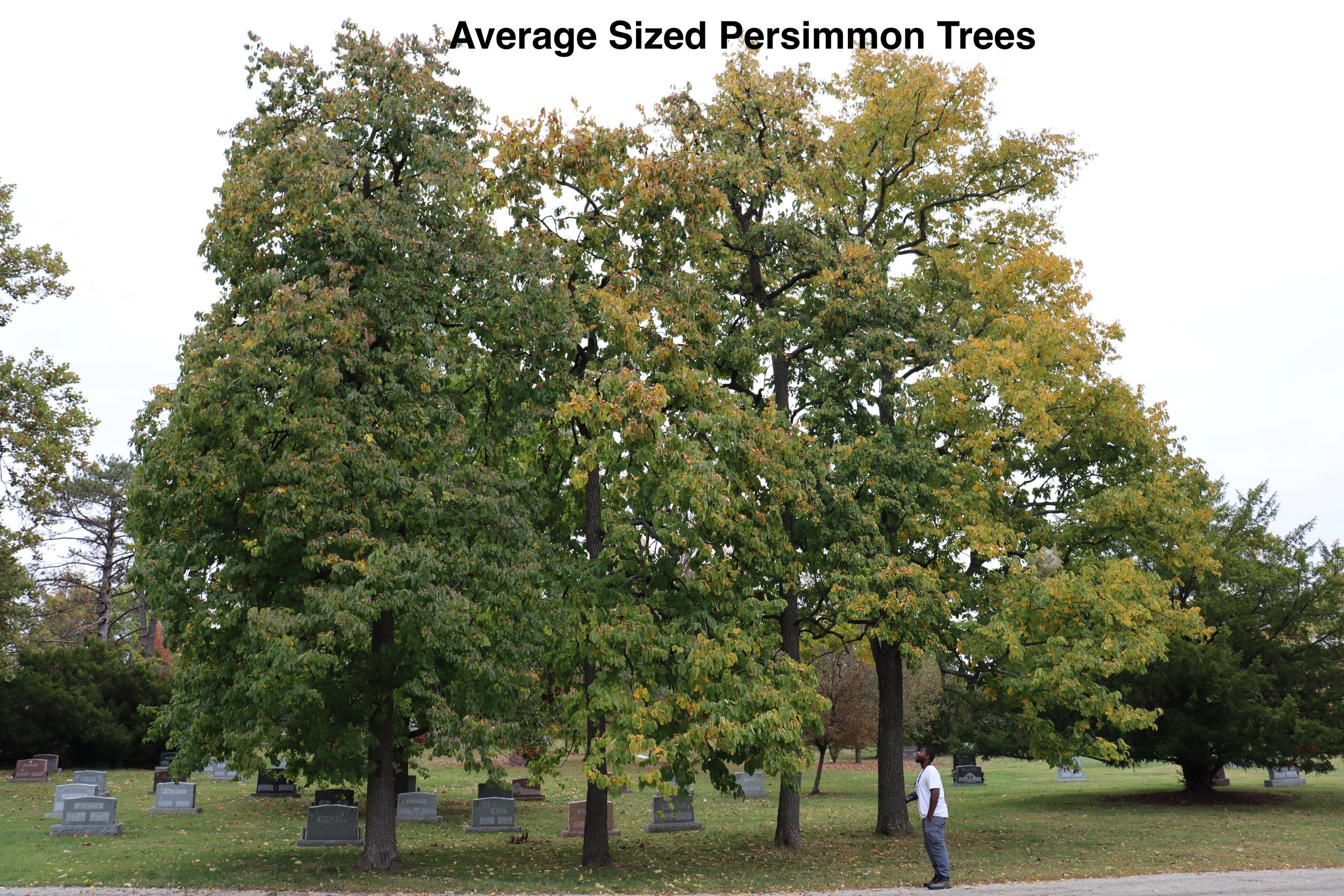The Ohio Champion Persimmon with human for scale, topping 87 feet tall by 46 feet wide.
In Native Plant Agriculture the native Persimmon’s adaptability and fruit productivity is unmatched. They may not achieve heights of over 40 feet tall on drier clay or sandy soils, but they will still out produce any other native or non-native fruit crop under those poor-soil conditions. They can be found from the Mississippi River floodplain to the high and dry landscapes of the Appalachian Mountain range. Persimmons naturally grow within grasslands, various forest types, savannas, and woodlands thriving in a wide PH range and wide moisture tolerance range from semi-dry to seasonally-saturated.
The cutting down of a Persimmon tree lead to the sprouting of over 40 persimmon trunks from the root system.
Personally I’ve witnessed a client cut down a single 25 foot tall persimmon tree unknowingly only for over 80 - 2 to 3 foot sprouts to arise from the root system the following summer. These would be clones though, and still need other genetically distinct trees to cross pollinate with to produce good fruit yields. Also if you didn’t know, Persimmon trees most of the time either produce male flowers or female flowers. The trees that produce the female flowers are the ones that produce fruit. Sometimes female trees can produce male flowers too.
Fire Makes Persimmon Thickets (Like pictured above)
Persimmons are very adapted to fire, in fact, fire only increases persimmon sprout growth. In one study in Oklahoma a summer prescribed burn increased persimmon sprouts from 542 individuals to 750. The winter burn was even worse for those seeking to destroy the persimmon trees, as stem quantity increased from just 17 to 583. Persimmon wood is also adapted to open prairie winds. The wood is dense and wind-tolerant to the point that these trees rarely break unless they’re near the end of their lifespan (rotten).
In just the average soils and climate of SW Ohio Persimmons reach heights of +60 feet in forest conditions, and 40 to 55 feet in open grown conditions. The largest persimmons top 80 feet in height but are still just 40-50 feet in canopy spread allowing a high density stocking rate per acre due to the columnar or “rocket” shape of the trees.
A forest grown native Persimmon tree.
Persimmons grow as much as the site conditions allow. They can be as large as an open grown Shagbark Hickory, or just a bit larger than a flowering dogwood when clinging to sandstone on a dry open ridge. They should not be undervalued for their carbon sequestering abilities. They may not be as massive as Oaks, Hickories, or Walnuts, but they can be stocked at a high density per acre. With their grassland adapted root system like that of prairie thicket species; they may be able to access water at depths of 4 feet deep or more. This is a known fact with prairie thickets species such as Hazelnut and Wild Plum, but unstudied as far as persimmon.
Click Images Below to Expand them.
Select/click the images above to expand them then click/tap to advance to the next picture. Also, Turn your cellphone side ways for horizontal pictures, and straight up and down for vertical pictures.
The pictures above depict the fruit size variation from tree to tree. Within a single wild population, fruit size may not vary greatly but as you travel to different populations you will notice fruit size variability. Human planted persimmons can have genetics from different regions causing high variability of fruit expressions.
Where exactly does this native persimmon of different shapes and sizes belong? The answer is, wherever wildlife deposits the seeds and the trees grow to maturity whether that be in Grasslands, Savannas, Woodlands, or Forests within its native range. They have proven themselves to be adapted to most midwestern, mid-atlantic, and southeastern ecosystems. And this wide range of adaptability makes them an excellent choice for Native Plant Agricultural production, food forests, and metropolitan or rural plantings within or near their native range.
Germination Tips: Extract the seeds from the fruit. Cold Moist Stratify the seeds outdoors in a heeled in container with drainage from the fall throughout the winter. Sow in the spring, expect germination by early summer.
Receive 40% off of our Native Plant Propagation Guide/Nursery Model book when purchased as a package. deal with either our Native Meadowscaping book or our Native Plant Agriculture book at this link.
Learn about what our Native Meadowscaping book has to offer here at this link.
Learn about what our Native Plant Agriculture Vol. 1 book has to offer here at this link.
Learn about what our Native Plant Propagation Guide & Nursery Model has to offer here at this link.







